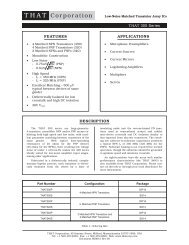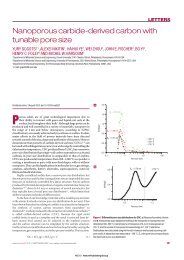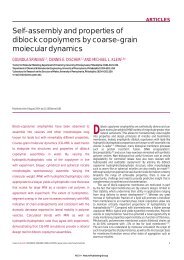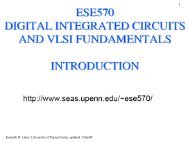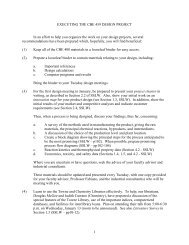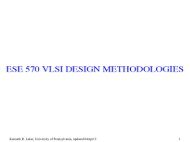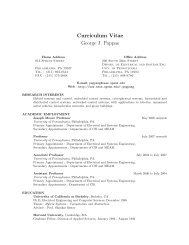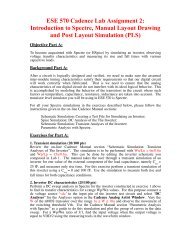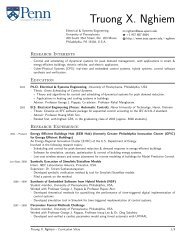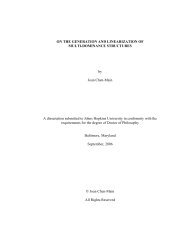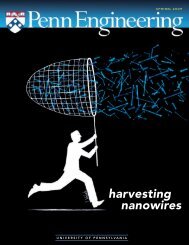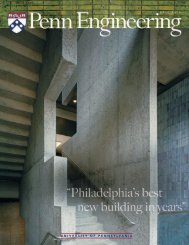Download PDF (9.49MB) - the School of Engineering and Applied ...
Download PDF (9.49MB) - the School of Engineering and Applied ...
Download PDF (9.49MB) - the School of Engineering and Applied ...
You also want an ePaper? Increase the reach of your titles
YUMPU automatically turns print PDFs into web optimized ePapers that Google loves.
www.seas.upenn.edu/~ese111/<br />
Atoms, Bits, Circuits<br />
<strong>and</strong> Systems<br />
By Jana Moore<br />
Nanotechnology. Robotics. Photonics. MEMS. Power<br />
grids. Stochastic processes. The fields encompassed by<br />
<strong>the</strong> Department <strong>of</strong> Electrical <strong>and</strong> Systems <strong>Engineering</strong><br />
(ESE) have become so broad <strong>and</strong> complex that even<br />
pr<strong>of</strong>essionals find keeping up difficult.<br />
Freshmen could easily feel overwhelmed by <strong>the</strong><br />
scope <strong>and</strong> breadth <strong>of</strong> ESE, until last fall, when <strong>the</strong><br />
Department took <strong>the</strong> rare step <strong>of</strong> <strong>of</strong>fering ESE 111:<br />
Atoms, Bits, Circuits <strong>and</strong> Systems (ABCs), a class<br />
proposed <strong>and</strong> partially designed by senior Kevin<br />
Conley <strong>and</strong> his fellow Teaching Assistants (TAs).<br />
“To get excited about <strong>the</strong> fields in ESE, it’s important<br />
that freshmen get h<strong>and</strong>s-on work <strong>and</strong> a flavor <strong>of</strong> <strong>the</strong><br />
different things you can do, <strong>and</strong> no one course gave<br />
<strong>the</strong>m that,” says Nick Howarth, one <strong>of</strong> <strong>the</strong> seven TAs<br />
who made an impassioned plea for <strong>the</strong> new overview<br />
class a year ago. Daniel Lee, pr<strong>of</strong>essor <strong>of</strong> Electrical <strong>and</strong><br />
Systems <strong>Engineering</strong>, had an additional goal: “I wanted<br />
<strong>the</strong>m to see how <strong>the</strong>y could change <strong>the</strong> world after<br />
underst<strong>and</strong>ing <strong>the</strong> underlying <strong>the</strong>ories.”<br />
A New Kind <strong>of</strong> Intro Class<br />
Lee <strong>and</strong> Siddharth Deliwala, Undergraduate Lab<br />
Manager, decided <strong>the</strong> lectures needed to take a far<br />
different tack from traditional introductory courses.<br />
“Instead <strong>of</strong> just teaching an overview, we wanted<br />
to utilize energetic <strong>and</strong> engaging guest speakers,”<br />
Deliwala says. “We focused on particular discrete<br />
areas as representative <strong>of</strong> entire subjects.”<br />
Lee addressed a wide spectrum <strong>of</strong> topics during<br />
lectures, from ma<strong>the</strong>matical models <strong>of</strong> circuits <strong>and</strong><br />
semiconductor physics <strong>and</strong> processing techniques<br />
to abstractions <strong>and</strong> analysis <strong>of</strong> large-scale systems.<br />
Guest speakers examined <strong>the</strong> application <strong>of</strong><br />
microelectronics outside <strong>of</strong> computing, <strong>the</strong> potential<br />
<strong>of</strong> nanoparticles <strong>and</strong> <strong>the</strong> complexities <strong>of</strong> power grids.<br />
For <strong>the</strong> midterm, <strong>the</strong> students analyzed <strong>the</strong> Apple vs.<br />
Samsung touch-screen lawsuit from an engineering<br />
<strong>and</strong> technological perspective.<br />
H<strong>and</strong>s-on at a High Level<br />
The labs, primarily designed by Howarth <strong>and</strong> fellow TA<br />
Sam Wolfson, roughly matched <strong>the</strong> focus <strong>of</strong> <strong>the</strong> lectures<br />
while introducing a variety <strong>of</strong> concepts, some <strong>of</strong> which<br />
are normally reserved for juniors. The first lab began<br />
with simple circuits but ended with MATLAB, powerful<br />
s<strong>of</strong>tware used to analyze <strong>and</strong> plot large data sets<br />
<strong>and</strong> control complicated experimental setups. Later,<br />
<strong>the</strong> students learned how to program <strong>the</strong> Arduino,<br />
an inexpensive open-source microcontroller platform<br />
popular worldwide.<br />
The use <strong>of</strong> sensors, LCDs, accelerometers, data<br />
acquisition, signal processing <strong>and</strong> wireless communication<br />
followed, along with constructing a portable<br />
USB charger. All <strong>the</strong> labs built up to <strong>the</strong> final project,<br />
designing <strong>and</strong> building a networked pedometer<br />
that interfaced with MATLAB <strong>and</strong> was capable <strong>of</strong><br />
sharing data with users.<br />
PENN ENGINEERING n 17



